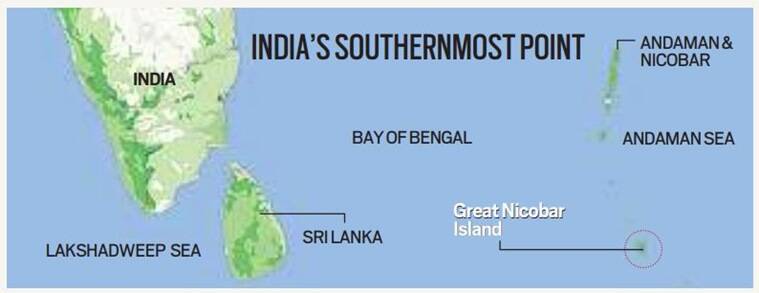Context:
Recently, the Ministry of Environment, Forest and Climate Change gave environmental clearance for the ambitious Rs 72,000 crore development project on the strategically important Great Nicobar Island.
Relevance:
GS III: Environmental Pollution & Degradation
Dimensions of the Article:
- About the proposal
- About Andaman and Nicobar Islands:
- Purpose of the development project:
- Concerns
About the proposal
- A “greenfield city” has been proposed, including an International Container Transhipment Terminal (ICTT), a greenfield international airport, a power plant, and a township for the personnel who will implement the project.
- The proposed port will allow Great Nicobar to participate in the regional and global maritime economy by becoming a major player in cargo transshipment.
- The port will be controlled by the Indian Navy, while the airport will have dual military-civilian functions and will cater to tourism as well.
- Roads, public transport, water supply and waste management facilities, and several hotels have been planned to cater to tourists.
- Development activities are proposed to commence in the current financial year, and the port is expected to be commissioned by 2027–28.
- More than 1 lakh new direct jobs and 1.5 lakh indirect jobs are likely to be created on the island over the period of development.
About Andaman and Nicobar Islands:

- Great Nicobar, the southernmost of the Andaman and Nicobar Islands, has an area of 910 sq km.
- The Andaman and Nicobar Islands are a cluster of about 836 islands in the eastern Bay of Bengal, the two groups of which are separated by the 150-km wide Ten Degree Channel.
- The Andaman Islands lie to the north of the channel, and the Nicobar Islands to the south.
- Indira Point on the southern tip of Great Nicobar Island is India’s southernmost point, less than 150 km from the northernmost island of the Indonesian archipelago.
- Great Nicobar is home to two national parks, a biosphere reserve, and the Shompen and Nicobarese tribal peoples, along with ex-servicemen from Punjab, Maharashtra, and Andhra Pradesh who were settled on the island in the 1970s.
- The Shompen are hunter-gatherers who depend on forest and marine resources for sustenance.
- The Nicobarese, who lived along the west coast of the island were mostly relocated after the 2004 tsunami.
- The Great Nicobar Island has tropical wet evergreen forests, mountain ranges reaching almost 650 m above sea level, and coastal plains.
- Fourteen species of mammals, 71 species of birds, 26 species of reptiles, 10 species of amphibians, and 113 species of fish are found on the island, some of which are endangered. The leatherback sea turtle is the island’s flagship species.
Purpose of the development project:
- The island has a lot of tourism potential, but the government’s greater goal is to leverage the locational advantage of the island for economic and strategic reasons.
- Great Nicobar is equidistant from Colombo to the southwest and Port Klang and Singapore to the southeast, and positioned close to the East-West international shipping corridor, through which a very large part of the world’s shipping trade passes.
- The proposed ICTT can potentially become a hub for cargo ships travelling on this route.
- The proposal to develop Great Nicobar was first floated in the 1970s, and its importance for national security and consolidation of the Indian Ocean Region has been repeatedly underlined.
- Increasing Chinese assertion in the Bay of Bengal and the Indo-Pacific has added great urgency to this imperative in recent years.
Concerns
- The proposed massive infrastructure development in an ecologically important and fragile region, including the felling of almost a million trees, has alarmed many environmentalists.
- The loss of tree cover will not only affect the flora and fauna on the island, it will also lead to increased runoff and sediment deposits in the ocean, impacting the coral reefs in the area, they have cautioned.
- Coral reefs, already under threat from warming oceans, are of enormous ecological importance. Environmentalists have also flagged the loss of mangroves on the island as a result of the development project.
-Source: The Hindu




